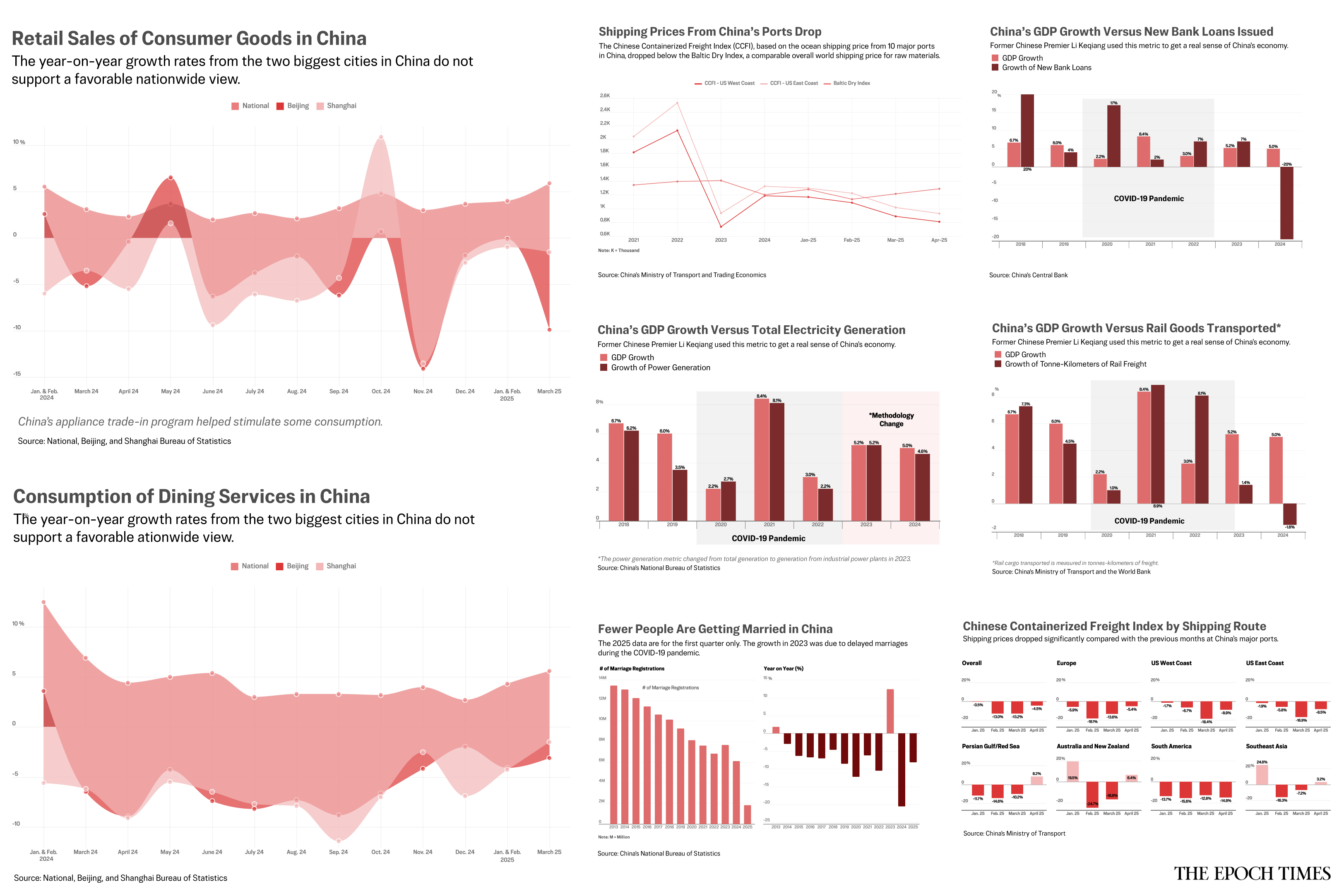China’s economy entered a sluggish recovery after Beijing lifted its stringent COVID-19 pandemic lockdowns at the end of 2022. Since then, Chinese economic data have shown an array of inconsistencies, painting a murky picture of what is going on in the country.
How bad is China’s economy? Are there better indicators of its condition than the regime’s official gross domestic product growth figure, currently at 5 percent?
Below, The Epoch Times has curated related data to offer insight into the real economic situation.
A Grim Outlook for Youth
Fewer people are getting married in China. Between 2013 and 2024, marriage registrations fell by half—from 13.5 million to 6 million per year—with a temporary increase in 2023, according to the National Bureau of Statistics.Following a 20 percent year-on-year decline last year, the number of marriage registrations in China fell by another 8 percent in the first quarter compared with the first three months of 2024.
Jean Yeung, professor of pediatrics at the National University of Singapore’s School of Medicine and president of the Population Association of Singapore, said that the number of marriages jumped in 2023 because of two factors: couples tying the knot after delaying their plans because of the COVID-19 pandemic and Chinese people wanting to get married before 2024, the Year of the Dragon, an especially auspicious zodiac sign under which to have a “dragon baby.”
Partly because of the growth in 2023, the number of marriage registrations in China sharply declined in 2024. Yeung said the high youth unemployment rate—16.5 percent in March versus the world’s average of 13 percent—was also a significant factor.
Home ownership has become a common precondition for marriage in China. Given the current economy and depressed housing market, many families are indebted because they owe more on their mortgages than their real estate properties are worth.
China’s fertility rate is about 1.7, below the 2.1 level necessary to sustain the country’s population.
To reverse the decline, Yeung said, the Chinese regime should focus on improving and restoring confidence in the economy. She noted that the “anxiety and inability to fulfill what people want in life” may worsen the population’s mental health.
“I think the overall atmosphere about the economy and what kind of world they are in is important for [the] marriage and fertility rate to even start to hopefully revert,” she told The Epoch Times.
Major Cities Show Deflation
Even though China’s retail sales of consumer goods have shown year-on-year growth each month for the past 15 months, the statistics in Beijing and Shanghai do not support a favorable national view.In the two first-tier cities, retail consumption declined almost every month during the same period. The only bright spots were due to an appliance trade-in program launched in March 2024, which stimulated goods consumption during major holidays thereafter.
Fewer Exports Mean Fewer Jobs
Exports made up one-third of China’s economic growth in 2024, according to the Mercator Institute for China Studies.Similarly, the China Containerized Freight Index is based on prices quoted from shipping companies at 10 major ports in China. The index reflects prices in the open market and therefore tends to be more reliable than other official economic data, which can be manipulated.
The freight index has dropped each month since January. In February, the Trump administration imposed 10 percent additional tariffs on China over its role in fentanyl trafficking. This was doubled to 20 percent in March.
April’s data reflect the impact of the United States’ escalation of tariffs to 145 percent.
Shipping prices at China’s ports have also dropped lower than comparable worldwide prices, as indicated by the Baltic Dry Index. The index measures container shipping prices for raw materials in major ports worldwide.
Newly released data show that China’s exports to the United States dropped by 20 percent year on year in April. A year-on-year increase in exports to Southeast Asian countries still supported overall growth in Chinese exports.
Cai Shenkun, an independent Chinese writer and commentator, estimated that the previous U.S. tariff rate of 145 percent would have led to 30 million to 40 million job losses in China. He said the 90-day tariff rollback will reduce the impact; however, whether the United States and China can reach an agreement in three months remains to be seen.
Although the effect of additional tariffs has been temporarily subdued, the structural issues plaguing China’s economy persist, Cai told The Epoch Times. When many families do not have income but still have to pay off debt and cover expenses for children and grandparents, it is possible for social unrest to erupt, he said.
Cai warned that there is even the risk of a humanitarian crisis, such as mass starvation, and the world may not know about it because of the communist regime’s tight control over information. The international community, he said, should be on high alert for such crises.
Li Keqiang Metrics
The late Chinese Premier Li Keqiang said in 2007 that his province’s GDP numbers were “man-made,” according to a leaked diplomatic cable. Back then, he was the Chinese Communist Party secretary of Liaoning Province in northeastern China, a position more powerful than that of governor.
Instead, he looked at three sets of numbers that were harder to falsify: electricity consumption, rail cargo volumes, and new bank loans issued.
Comparing annual growth rates of the so-called Li Keqiang metrics to Beijing’s GDP growth rates reveals many discrepancies.
When total electricity generation, rail cargo transportation, and new bank loan issuance showed weak or negative growth in recent years, national economic growth remained at 5 percent or above, except during the COVID-19 pandemic.
Instead of electricity consumption, The Epoch Times looked at electricity generation data from China’s National Bureau of Statistics. That is because Chinese citizens complained that their meter readings had been inflated, according to Chinese media reports. Unlike with natural gas, power storage is uncommon. Hence, power generation may be a more reliable metric than power consumption.
In 2023, China changed its methodology for reporting the electricity generation number. After the change, the annual growth rate jumped by 3 percent.
Instead of looking at rail cargo volume in tonnes, The Epoch Times used tonne-kilometers of freight to track growth rates over the years. The metric is more telling than mere volume because it also incorporates the transportation distances.
The amount of new bank loans in 2024 declined by 20 percent year on year, according to China’s central bank, the People’s Bank of China.
With negative growth in both new bank loans and rail cargo transported, and 4.6 percent electricity generation growth, the official GDP growth figure of 5 percent overall seems to be a mathematical stretch.












